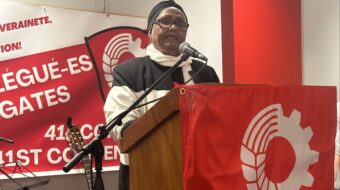Despite considerable skepticism about the Israeli-Palestinian conference convened by President Bush in Annapolis, Md., Nov. 27, Jewish and Palestinian American peace advocates say it offers an opportunity for peace, if peace supporters keep the pressure on.
With Israeli Prime Minister Ehud Olmert and Palestinian President Mahmoud Abbas standing beside him, Bush announced the Israeli and Palestinian leaders had agreed to work toward achieving a peace treaty by the end of 2008.
However, the agreement contained no specifics on a negotiations timetable or on the fundamental issues for resolving the 60-year crisis: the borders of a Palestinian state, the status of Jerusalem, Israeli settlements in the West Bank, security concerns and the rights of Palestinian refugees. It did not mention the Arab Peace Initiative, widely seen as offering a useful basis for negotiating a just and realistic peace.
Delegations representing 49 countries and international organizations attended, including Saudi Arabia and Syria. China, South Africa and Brazil were also among the countries represented. Iran was not invited.
“Everyone can see the flaws,” said Hussein Ibish, senior fellow at the American Task Force on Palestine, a Palestinian American group advocating a two-state solution. He told the World, “It’s easy to be pessimistic, and a lot of grounds for that.” Nevertheless, he said, one has to ask, “How would it really look if a peace process would be started? It would look a lot like this.”
In a September article, Ibish wrote, “There is no military solution to this conflict for either side,” and “the only serious prospect of ending the conflict” is through a negotiated settlement. “This is not a perfect or ideal solution,” he observed then. “Few political constructs ever are.”
Mark Rosenblum, founder of Americans for Peace Now and head of the Jewish Studies program at Queens College in New York, said Annapolis should be seen as “a showplace, not a workplace.” He told the World, “Anything that is substantive has to have showplaces.” The essence, he said, is what kind of “workplaces” will emerge out of this.
If the process goes forward, it can energize the Israeli and Palestinian public, the majority of whom want a negotiated settlement, Rosenblum said.
Noting the U.S. public is not actively involved on this issue, he said the “silent majority” needs to be inspired and mobilized to tell Congress, “We support a peace process that is real, not imaginary.”
“Bush can’t be allowed to sell this as political spin,” he said.
Another U.S. group, Jewish Voice for Peace, said in a statement that while Annapolis itself would offer “little more than a chance for a few speeches and photo-ops,” it “could mark the beginning” of an important process.
“There is, of course, every reason for a lack of faith in the Bush administration. But until January 2009, this is the administration we have.” It is essential, the group said, that “both this and the next administration hear a clear message” for peace.
The group said it “considers this an opportunity to push even harder” for the steps necessary to realize “a just and lasting peace agreement: an end to Israel’s occupation of Palestinian lands, an end to violence directed at Israeli civilians, a shared Jerusalem and a just and practical resolution to the Palestinian refugee issue.”
James Zogby, president of the Arab American Institute, expressed a similar sentiment in a recent article. “I’m not optimistic, but still want to be supportive. I say this because the consequences of failure can only compound the devastation and trauma experienced by so many innocent people,” he wrote. After Annapolis, Zogby said, the burden will be on the U.S. to do “what it failed to do before — to press Israel to deliver meaningful concessions in the interests of peace.”
Many commentators see the U.S.-Iran power struggle as a driving factor behind the conference. Phyllis Bennis, of the Institute for Policy Studies, warned that the administration’s “sudden renewal of interest in and commitment to a new Middle East ‘peace process’ has two main goals: buying support from Arab regimes for Washington’s war in Iraq and escalating threats against Iran.”
The U.S.-Iranian rivalry is clearly a factor, Ibish said, but also important is the severe damage to the U.S. image from the Bush “fiasco” in Iraq, along with other damaging Bush policies, including rejection of the Kyoto global warming treaty. The administration, he said, is looking “to shore up the credibility” of the U.S. in the Middle East and internationally.
“Many, many significant senior people in the establishment are saying more loudly than ever” that if the U.S. is seriously interested in undoing the damage to its world standing, “the single most important thing is to try to fix this problem,” Ibish said.
In October, a bipartisan group of policy heavyweights including Zbigniew Brzezinski, Lee Hamilton and Brent Scowcroft sent a letter to Bush and Secretary of State Condoleezza Rice calling for “bold steps” for a two-state Israel-Palestine solution, saying the conference “should set in motion credible and sustained permanent status negotiations under international supervision and with a timetable for their completion.”
suewebb @pww.org










